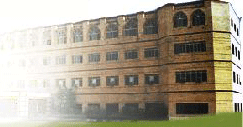


| Portal Links |
About Us

Administration

Admissions

Online registration

Current Events

Content Window
DEPARTMENT OF INDUSTRIAL BIOTECHNOLOGY 
Dr. Rama Vaidyanathan, M.Sc. Ph.D.
Head, Department of Industrial Biotechnology
TEACHING
• Plant Physiology and Biochemistry
• Bioinformatics and Genomics
Research
Aromatic and Medicinal Plants
Plants are rich in a wide variety of secondary metabolites, such as tannins, terpenoids, alkaloids, and flavonoids, which have been found in vitro to have antimicrobial properties and a wide variety of medicinal uses. Ocimum is a member of a the large plant family, Lamiaceae that includes the mints, sages, and basils and is well recognized for the diversity of secondary compounds synthesized and stored in glands found on the surface of leaves, stems, and flowers.
The essential oils of Ocimum is due to the phenylpropenes – methylchavicol or eugenol . These essential oils are sequestered in specialized cells called peltate glands. To understand the mechanisms of secondary metabolite biosynthesis in Ocimum sp we are using a functional genomics approach
Analysis Of G ene E xpression P attern I n P eltate G land O f Ocimum b asilicum By EST Clustering
Thesis submitted by Ms. Subhashini to Faculty of Biotechnology, AC College of Technology, Anna University in partial fulfillment of M.Tech. Biopharmaceutical Technology.
Environmental Biotechnology
Environmental Biotechnology is defined as the development, use and regulation of biological systems for bioremediation of contaminated environments (land, air, water) and for environmentally friendly processes such as green manufacturing technologies and sustainable development.
Our work involves (1) screening of the local environment for microorganisms especially with respect to multi-drug resistance (2) Bioremediation approaches using Microbes with a focus on Saline Soils and Waste Management methods.
Research Scholar : Ms. C.Kamatchi
Publications :
1. Vaidyanathan, R , Kuruvilla S and Thomas G (1999) Characterization and Expression pattern of an abscisic acid osmotic stress responsive gene in Rice. Plant Science 140: 25-36.
2. Buschmann P, Vaidyanathan R ., Gassmann W and Schroeder JI (2000) Enhancements of Na+ uptake currents, time-dependent inward-rectifying K+ channel currents, and K+ channel transcripts by K+ starvation in wheat root cortical cells. Plant Physiology 122: 1387-1398.
3. Maser P, Eckelman B, Vaidyanathan R , Horie T, Fairbairn DJ, and Kubo M, Yamagami M, Yamaguchi K, Nishimura M, Uozumi N, Robertson W, Sussman M.R., and Schroeder JI (2002) Altered shoot/root Na+ distribution and bifurcating salt sensitivity in Arabidopsis by genetic disruption of the Na transporter AtHKT1 . FEBS Letters 26654 (2002) 1-5.
Conference Presentations
• Rama Vaidyanathan (2004), Comparative Genomics of Bacterial Pathogens : a Paper presented at the National Symposium on “ DNA – Drug Design”, Vel's College of Science , Chenani, Oct 7-8 2004
(2 ) Rama Vaidyanathan, (2004) Microbial Comparative Genomics : A paper presented at the Symposium on Bioinformatics, Mother Theresa Women's University, Kodaikanal, August 27 – 28 2004, PUBLISHED IN the Selected Procedings.
(3) Vaidyanathan, R and George Thomas (1995) Salt Stress Responses in Rice : A Poster Presented at the Third International Rice Genetics Symposium, IRRI, Philippines , October 16-20, 1995
Educational Background:
Degree |
Specialization |
Year |
University/Institute |
B.Sc.(Honours) |
Botany |
1987 |
University of Delhi |
M.Sc. |
Biotechnology |
1989 |
Madurai Kamaraj University |
Ph.D. |
Biotechnology |
1998 |
Centre for Biotechnology, SPIC Science Foundation, Chennai ( Univ. of Madras ) |
Career Profile:
Year |
Post |
University/Company |
Research |
Teaching |
1998-2000 |
Post Doctoral Fellow |
Dept. of Biology, Univ of California , San Diego , USA |
Plant functional Genomics and Ion Transporters |
|
2003-2004 |
Faculty |
Amrutanjan Ltd. |
|
Bioinformatics |
Jan 2005-May 2005 |
Visiting Faculty |
Centre for Biotechnology, Anna University , Chennai |
|
Plant Biotechnology and Molecular Biology |
May 2005 |
Head |
Dept. of Biotechnology, Dr. M.G.R. Educational and Research Institute |
-Medicinal Plants, Microbial Genomics
|
Plant Biology, Bioinformatics |
Awards and Memberships in Professional Bodies:
- CSIR – JRF (1989)
- CSIR – SRF (1992)
- Post Doctoral Fellowship ( Univ. of California , San Diego ), 1998-2000
- Life Member - Indian Biophysical Society
- All India Biotech Association – Ordinary Member
© 2006 Dr.M.G.R Educational & Research Institute
